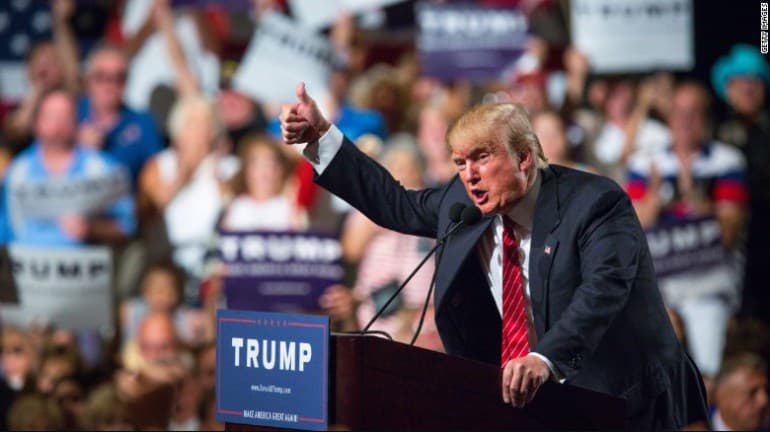By Travis Vance
An otherwise entertaining and unique election cycle took a violent turn Friday night.
Angry protestors stormed a planned Donald Trump rally at a convention center in Chicago, inciting violence among attendees with several insults yelled and many punches thrown. The protesting spilled over into the street outside the arena, where many protestors were restrained by police for violent behavior.
Fearing for the safety of his campaign workers and supporters under these circumstances, Trump cancelled the event.
The violence continued on Saturday, with a protestor rushing the stage at a Trump rally in Ohio. Secret service agents did an excellent job responding to the incident, and easily stopped the protestor and rushed onto the stage to protect the candidate.
Fortunately, no one was seriously injured from either event.
Is Trump obligated to protect workers at campaign rallies?
One would hope this violent behavior will end soon. But it only appears to be getting started. The incidents this past weekend are unfortunately only another wave in an increase of violent activities we have seen over the last several months. This includes several workplace shootings in locations across the country, including Kansas and California.
Given the recent increase in violence, safety for Trump campaign attendees and workers must be a paramount concern going forward. If violence continues at these gatherings, the campaign will need to add even more security to protect its staff.
Although the campaign will undoubtedly take steps to keep people safe as a matter of principle, one wonders what legal obligations the campaign has to protect its workers.
If protestors continue to throw punches, tackle each other, and rush the stage, would the Occupational Safety and Health Administration get involved and stop these dangerous events?
Why OSHA probably wouldn’t get involved
Here’s the analysis:
- An employer-employee relationship must be present. Trump uses several volunteers to support his candidacy. OSHA does not have jurisdiction over sites where only volunteers are present. If any employees work with the volunteers at these rallies, however, OSHA jurisdiction would be triggered if hazards are present. Likewise, OSHA does not get involved when only spectators or attendees (e.g., non-employees) are in danger. That’s where the police come in.
- Does the Trump campaign employ its workers? OSHA has jurisdiction over workplace safety issues affecting employees but not independent contractors. A case-by-case analysis must be used to determine if campaign workers are employees or independent contractors. This analysis includes an examination of various factors concerning the control the employer has over the employee. If Trump workers are considered independent contractors, OSHA has no jurisdiction. although OSHA might consider treating the rally as a multiemployer site and determining if other employers have employees exposed. For instance, security workers may not be Trump’s employees, but work for a different employer.
- What OSHA standards would apply? Because there is no standard on point, OSHA would have to rely on the general duty clause in citing the campaign for any workplace hazards. This clause requires employers to provide employees a safe place to work. We’ve seen a recent increase in general duty clause citations relating to workplace violence in industries where OSHA involvement is historically minimal, like healthcare. If employees are routinely subjected to punching, kicking, or worse, OSHA may take action if the employer fails to take steps to prevent such injuries.
- Would OSHA ever show up at a Trump rally? Probably not. An inspection of a campaign’s workplace would likely occur only if an employee made a complaint. Political camps are not usually considered “high hazard” industries. An OSHA inspector would likely not have the occasion to otherwise inspect a Trump gathering unless he or she was walking by and saw “imminent danger” to employees.
- Could OSHA shut down the rally? Not likely. The original version of the OSH Act bill allowed a compliance officer to shut down an employer’s facility if an “imminent danger” to employees was present. This provision, however, was ultimately taken out of the law. In most states, including Illinois and Ohio, OSHA does not have the authority to stop an employer’s operations. Employees, of course, can refuse to work if they have a reasonable basis to believe the danger of imminent death or serious injury is present.
Employee hazards are everywhere
Political campaigns, OSHA, and workplace safety don’t often intersect. Unfortunately, the spectrum of circumstances under which workplace hazards can be present continues to expand.
Prior to last weekend, one would have never thought about OSHA being pertinent to a political gathering. OSHA is generally known as an agency that inspects construction sites and manufacturing facilities. That is no longer the case.
Hazards to employees can arise nearly anywhere. If employees are exposed to a safety risk, no matter the circumstances, the requirements under the OSH Act can be triggered.
Let’s hope everyone stays safe and this discussion is short lived.
This was originally published on Fisher & Phillips Workplace Safety and Health Law blog.
